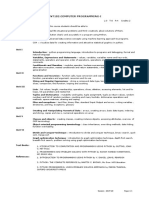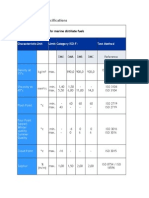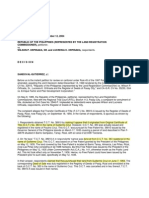0 ratings0% found this document useful (0 votes)
52 viewsPython PRogramming QB
This document contains a question bank for the subject "Python Programming" with various units and questions. It includes 15 questions for each of the 5 units - Unit I covers basic Python concepts like data types, operators, control flow etc. Unit II covers Python data structures like lists, tuples, dictionaries, files handling and exceptions. Unit III covers OOP concepts like inheritance, encapsulation, operator overloading. Unit IV introduces NumPy for numerical operations. Unit V discusses data visualization and analysis using libraries like Matplotlib and Pandas. Each question specifies the marks, course outcome and blooms taxonomy level.
Uploaded by
arjunCopyright
© © All Rights Reserved
Available Formats
Download as DOCX, PDF, TXT or read online on Scribd
0 ratings0% found this document useful (0 votes)
52 viewsPython PRogramming QB
This document contains a question bank for the subject "Python Programming" with various units and questions. It includes 15 questions for each of the 5 units - Unit I covers basic Python concepts like data types, operators, control flow etc. Unit II covers Python data structures like lists, tuples, dictionaries, files handling and exceptions. Unit III covers OOP concepts like inheritance, encapsulation, operator overloading. Unit IV introduces NumPy for numerical operations. Unit V discusses data visualization and analysis using libraries like Matplotlib and Pandas. Each question specifies the marks, course outcome and blooms taxonomy level.
Uploaded by
arjunCopyright
© © All Rights Reserved
Available Formats
Download as DOCX, PDF, TXT or read online on Scribd
You are on page 1/ 3
Department of MCA
Subject Name: Python Programming
Sub Code: 22MCA201
Question Bank
Sl. No. UNIT-I Marks CO; BL
1. Discuss the different types of break and continue statements in 10 CO1; L2
Python with proper syntax and examples.
2. Illustrate the concept of identifier with examples also list the set of rules to 05 CO1; L2
create an identifier.
3. Discuss about the arithmetic, assignment, comparison and bitwise 10 CO1; L2
operators with examples.
4. Interpret identity and membership operators in python with proper 05 CO1; L1, L2
code snippet.
5. List and explain the basic types of arguments used in functions 10 CO1; L2
6. Discuss the working of if statements with examples. 06 CO1; L2
8. Discuss the importance indentation of python with example 05 CO1; L2
9. Define Function and give general form for defining and calling Functions 10 CO1; L1, L2
in Python with examples.
10. Discuss the working of Anonymous functions in python. 05 CO1; L2
11 Interpret the following in python functions with suitable code 10 CO1; L2
snippet:
i)Positional arguments ii) Keyword arguments iii) Variable length
arguments
12 Write a python program to add n numbers accepted from the user input. 05 CO1; L3
13 Discuss Mutable and Immutable Data Types in python 05 CO1; L2
14 Implement a python program to search an element using linear search 05 CO1; L3
15 Implement a python program to search an element using Binary search 05 CO1; L3
16 Write Python code to check if a given year is a leap year or not. 6 CO1; L3
UNIT II
1. Discuss the List basic operations in detail. Explain different 10 CO2;L2
operation on List like extend, insertion, deletion etc.
2. Implement a python program to simulate stack operations using list. 8 CO2; L2
3. Discuss the slicing and indexing methods of strings with examples 8 CO2; L2
4. Discuss the basic string methods with examples 10 CO2; L2
5. Discuss the working of dictionary in python 05 CO2; L2
6. With an example explain the file handling methods of python with 10 CO2; L2
examples
7. Implement the python code to depict the different insertion operations to 6 CO2; L3
perform on List.
8 Discuss the set basic operations in detail. Explain different 10 CO2;L2
operation on set like extend, insertion, deletion etc.
9. Discuss the tuples basic operations in detail. Explain different 10 CO2;L2
operation on tuples like extend, insertion, deletion etc.
10 Illustrate exception handling in Python with suitable examples. 10 CO2; L2
11 Implement the python code to depict the different deletion operations to 6 CO2; L3
perform on dictionary.
12 Implement the python code to depict the different insertion operations to 6 CO2; L3
perform on sets.
13 Discuss the following dictionary methods with an example. CO2; L2
12
a) get() b) keys() c) pop() d) update() e) values() f) items()
UNIT III
1. With an example explain the concept of Inheritance with example 8 CO2; L3
2. Discuss the creation of constructors in python 5 CO2; L2
3. Illustrate the creation of class and object with proper syntax and 5 CO2; L2
example.
4. Create a Bus object that will inherit all of the variables and methods of the 6 CO2; L3
parent Vehicle class and display it.
5. Write a python program using object oriented programming to 10 CO2; L3
demonstrate encapsulation, overloading and inheritance
6. Explain operator overloading with the help of an example 5 CO2; L2
7. Write a brief note on PIP. Explain installing packages via PIP 6 CO2; L2
8. What are the two ways of importing a module? Which one is more 5 CO2; L2
beneficial? Explain
9. List out the types of Modules and Explain any two types in detail 10 CO2; L2
10. What is JSON? Discuss with example. Compare it with dictionary 8 CO2; L2
11. What are Regular expressions? What are the different steps to be 5 CO2; L2
followed to use a regular expression in Python.
12. Describe with suitable python code snippet the working of find all(), 8 CO2; L3
search(),split(),sub() with examples.
13. What is a package? How to download a package, import a package, 8 CO2; L2
remove a package in python.
UNIT IV
1. Discuss the process of web scrapping in python. 10 CO4; L2
2. Elaborate the creation and working of ndarrays in python with 10 CO4; L2
suitable examples.
3. Briefly explain the NumPy array slicing with example 05 CO4; L2
4. Interpret the python universal function ufunc in brief. 10 CO4; L2
5. Discuss the NumPy data types in brief 05 CO4; L2
6. Interpret the following in python functions with suitable code 10 CO4; L2
snippet:
1. Sum 2. Min 3. max
7. Discuss the basic numerical operations on NumPy arrays 10 CO4; L2
8. Discuss the rules of array broadcasting (Computation on arrays) in 5 CO4; L2
python
UNIT V
1. Discuss the concept of data visualization in python 05 CO5; L2
2. Discuss the different Python Libraries used for data visualization 05 CO5; L2
3. Discuss Matplotlib visualization library in depth 10 CO5; L2
4. Describe the methods used to identify and handle missing and Handling 10 CO5; L2
Duplicates values in a Data Frame
5. Discuss univariate (box plot) nature of visualization with a snippet 10 CO5; L2
of code
6. Discuss bivariate (scatter plot) nature of visualization with a snippet 10 CO5; L2
of code
7. Discuss the countplot and histogram features of visualization 10 CO5; L2
8. With example explain head (), tail (), iloc () method 10 CO5; L2
9. Illustrate the working of data frame. aggregate function in pandas 05 CO5; L2
10. Briefly discuss how a CSV file can be loaded in python 05 CO5; L2
11. Discuss the working of strip function in python 05 CO5; L2
12. Discuss the aspects of data preprocessing in python 10 CO5; L2
13. Discuss the working of panda’s series object with example 10 CO5; L2
14. Discuss the working of pandas Data Frame with examples 10 CO5; L2
15. Discuss the steps involved in Data wrangling process in python 10 CO5; L2
You might also like
- 18IS752-Python Programming Model Question Papers SEE March-April-2022No ratings yet18IS752-Python Programming Model Question Papers SEE March-April-20226 pages
- Python Programming Unitwise Important QuestionNo ratings yetPython Programming Unitwise Important Question4 pages
- Cse - R21 - Ge3151 - Problem Solving and Python ProgrammingNo ratings yetCse - R21 - Ge3151 - Problem Solving and Python Programming16 pages
- 22PLU105B 205B IntroductionToPython-22PLC1052No ratings yet22PLU105B 205B IntroductionToPython-22PLC10523 pages
- Chapter / Topic Details: Sr. No. No. of Hours Introduction To PythonNo ratings yetChapter / Topic Details: Sr. No. No. of Hours Introduction To Python2 pages
- Python Full Textbook Technical PublicationsNo ratings yetPython Full Textbook Technical Publications158 pages
- S. G. Balekundri Institute of Technology: Examination Section Department of Compuuter Science and EngineeringNo ratings yetS. G. Balekundri Institute of Technology: Examination Section Department of Compuuter Science and Engineering3 pages
- Mastering Python Programming: A Comprehensive Guide: The IT CollectionFrom EverandMastering Python Programming: A Comprehensive Guide: The IT Collection5/5 (1)
- 5039 - Assignment 1 - Nguyen Phan Thao My - GBD1101No ratings yet5039 - Assignment 1 - Nguyen Phan Thao My - GBD110136 pages
- Industrial Engineering Mec 422 2 Unit Course Note WK1-3No ratings yetIndustrial Engineering Mec 422 2 Unit Course Note WK1-38 pages
- The Mode of Transportation Utilized by Medical Technology Students of Emilio Aguinaldo College - ManilaNo ratings yetThe Mode of Transportation Utilized by Medical Technology Students of Emilio Aguinaldo College - Manila12 pages
- Lag, Lead, Lead-Lag - Compensation in Control System100% (2)Lag, Lead, Lead-Lag - Compensation in Control System11 pages
- Competitive Strategy Within Engineering Management (2533)No ratings yetCompetitive Strategy Within Engineering Management (2533)7 pages
- 22.electromotive Force and Potential DifferenceNo ratings yet22.electromotive Force and Potential Difference4 pages
- 119.) 149.product Bulletin Fisher Fieldvue Digital Valve Controller Product Selection en 6112860No ratings yet119.) 149.product Bulletin Fisher Fieldvue Digital Valve Controller Product Selection en 611286010 pages
- High Level Impacts GST Training & SAP Landscape - High Level Impacts. Compliance To Legal Requirements? Efficiency That Reduces Costs?No ratings yetHigh Level Impacts GST Training & SAP Landscape - High Level Impacts. Compliance To Legal Requirements? Efficiency That Reduces Costs?9 pages
- Activity 1: K-W-L Chart What I Know What I Want To Know What I LearnedNo ratings yetActivity 1: K-W-L Chart What I Know What I Want To Know What I Learned5 pages
- Potential Liquefaction of Locations Along The Pasig City Segment of The Valley Fault SystemNo ratings yetPotential Liquefaction of Locations Along The Pasig City Segment of The Valley Fault System87 pages
- (Ebook) Linear Feedback Control: Analysis and Design with MATLAB (Advances in Design and Control) by Dingyu Xue, YangQuan Chen, Derek P. Atherton ISBN 9780898716382, 0898716381 - The full ebook with all chapters is available for download100% (1)(Ebook) Linear Feedback Control: Analysis and Design with MATLAB (Advances in Design and Control) by Dingyu Xue, YangQuan Chen, Derek P. Atherton ISBN 9780898716382, 0898716381 - The full ebook with all chapters is available for download59 pages
- Aesthetic Experience: and Literary HermeneuticsNo ratings yetAesthetic Experience: and Literary Hermeneutics389 pages
- Cleaning Public Areas: by Mumtazul IlyaniNo ratings yetCleaning Public Areas: by Mumtazul Ilyani27 pages





























































































